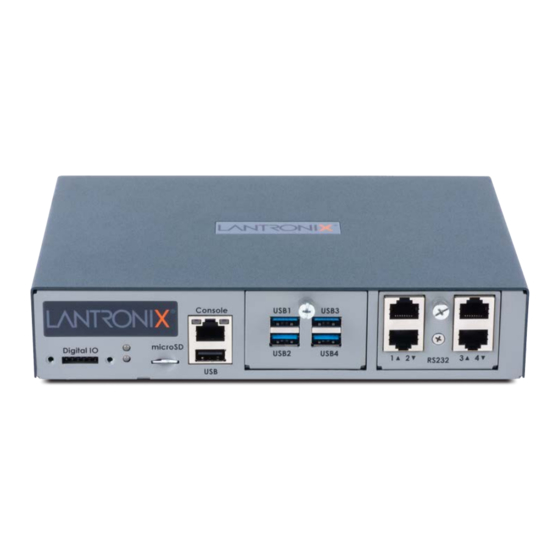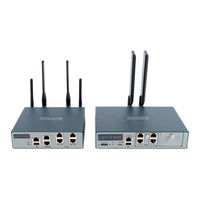
Lantronix EMG 8500 Manuals
Manuals and User Guides for Lantronix EMG 8500. We have 5 Lantronix EMG 8500 manuals available for free PDF download: User Manual, Quick Start Manual
Lantronix EMG 8500 User Manual (555 pages)
Edge Management Gateway
Table of Contents
-
Warranty2
-
Key Features25
-
Security26
-
Power26
-
Applications26
-
I/O Modules33
-
Power Input48
-
Power Input63
-
IP Address65
-
Next Step72
-
Web Manager74
-
Logging in76
-
Logging out77
-
Logging in77
-
Logging out78
-
Tips78
-
Requirements81
-
Gateway88
-
FQDN List97
-
Cellular Status103
-
Troubleshooting111
-
Ethernet Switch121
-
Port Statistics123
-
Switch Commands125
-
Vlans125
-
VLAN Commands126
-
Dhcp126
-
DHCP Commands129
-
IP Filter130
-
Mapping Rulesets130
-
Rule Parameters133
-
Routing135
-
Dynamic Routing135
-
Routing Commands137
-
Forwarding137
-
VPN Settings139
-
VPN Commands155
-
8: Services167
-
System Logging169
-
Audit Log169
-
Ssh170
-
Telnet170
-
Smtp171
-
Discovery Server172
-
SSH Commands172
-
Logging Commands172
-
Snmp172
-
Version 3177
-
V3 User Trap177
-
NFS and SMB/CIFS179
-
SMB/CIFS Share181
-
Browser Issues184
-
Date and Time188
-
Web Server191
-
Percepxion197
-
Manage Files207
-
Data Settings210
-
IP Settings210
-
USB Commands210
-
SD Card Commands210
-
10: Device Ports211
-
Permissions211
-
I/O Modules212
-
Device Status213
-
Device Ports213
-
IP Settings220
-
Data Settings221
-
Device Commands231
-
Local Logging233
-
NFS File Logging233
-
Syslog Logging234
-
Local Logging237
-
NFS File Logging237
-
Syslog Logging237
-
Logging Commands238
-
Console Port238
Advertisement
Lantronix EMG 8500 User Manual (482 pages)
Edge Management Gateway
Table of Contents
-
Warranty2
-
Contacts2
-
-
Key Features24
-
Applications25
-
-
I/O Modules32
-
-
-
Power Input48
-
-
-
Power Input61
-
-
IP Address63
-
Next Step71
-
-
Web Manager72
-
-
-
Requirements79
-
-
DNS Servers85
-
Gateway86
-
IP Filter110
-
Routing115
-
Dynamic Routing115
-
Static Routing115
-
Routing Commands116
-
-
VPN Settings116
-
Security133
-
-
FQDN List146
-
-
8 : Services
147-
-
System Logging148
-
Audit Log149
-
Smtp149
-
Ssh149
-
Telnet150
-
SSH Commands151
-
Logging Commands151
-
-
Snmp151
-
Version 3154
-
V3 User Trap155
-
NFS and SMB/CIFS156
-
-
Browser Issues160
-
Date and Time164
-
Web Server166
-
Consoleflow171
Lantronix EMG 8500 User Manual (416 pages)
Edge Management Gateway
Table of Contents
-
Warranty2
-
Contacts2
-
-
Key Features22
-
Applications23
-
-
I/O Modules30
-
-
-
Power Input46
-
-
IP Address50
-
Next Step58
-
-
Web Manager59
-
-
-
Requirements66
-
-
DNS Servers72
-
Gateway73
-
IP Filter79
-
Routing83
-
VPN Settings84
-
Security101
-
-
FQDN List113
-
-
7 : Services
114-
-
System Logging115
-
Audit Log116
-
Smtp116
-
Ssh116
-
Telnet117
-
SSH Commands118
-
Logging Commands118
-
-
Snmp118
-
Version 3121
-
V3 User Trap122
-
NFS and SMB/CIFS122
-
-
Browser Issues127
-
Date and Time131
-
Web Server133
-
Consoleflow138
-
9 : Device Ports
148-
Permissions148
-
I/O Modules149
-
Device Status150
-
Device Ports150
-
-
IP Settings157
-
Data Settings158
-
Device Commands168
-
-
Local Logging169
-
NFS File Logging169
-
Syslog Logging170
-
Local Logging173
-
NFS File Logging173
-
Syslog Logging173
-
Logging Commands174
-
-
Console Port174
-
DIO Port175
-
DIO Commands176
-
-
Xmodem176
-
Sites183
-
-
Dial in186
-
Dial-Back187
-
Dial-On-Demand188
-
CBCP Server190
-
CBCP Client190
-
Key Sequences191
-
Advertisement
Lantronix EMG 8500 Quick Start Manual (2 pages)
Table of Contents
Advertisement




